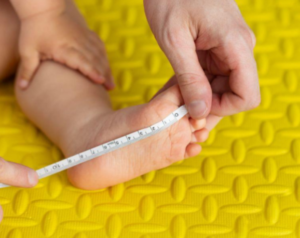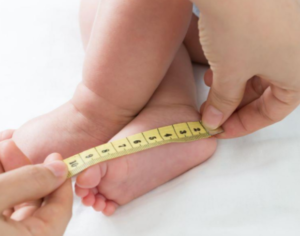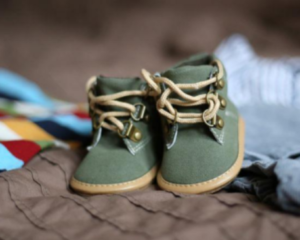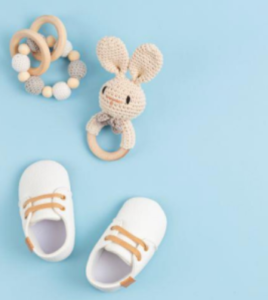
If you’re anything like me, becoming a parent throws you into a world of unknowns. Whether you are choosing the perfect crib or figuring out why your baby is crying at 3.a.m. – everything feels like a challenge. But one thing I never expected to be so tricky was understanding baby shoe sizes!
At some point you thought you had nailed it in terms of matching it perfectly – then when your baby put it on, it just wouldn’t fit. Sound familiar? Don’t worry—you’re not alone! Let’s make this less of a headache for you. I’ll break down everything you need to know about baby shoe sizes so you can shop confidently.
Why understanding baby shoe sizes matters
Your baby’s feet are growing faster than you can say “peek-a-boo.” On average, a baby’s feet grow about 1-1.5 sizes every 2-3 months during their first year. And because their tiny feet are soft and still developing, an ill-fitting shoe can do more harm than just causing discomfort—it can affect how they learn to walk. This is why some parents refuse to put shoes on their babies within their first 5 months.
But of course, some also want to give their child the best possible start. After all, shoes that fit well will provide the right support for their wobbly first steps or even prevent them from having blisters of pinched toes.
The basics of baby shoe sizes
Here’s where things get tricky: baby shoe sizes don’t follow the same logic as adult sizes. Instead of numbered sizes that we’re used to, baby shoes often correspond to age ranges or foot length in inches or centimeters.
Another thing is that every brand does sizing a little differently (which is also a reality to most adult shoes). One brand’s size “3-6 months” might fit perfectly, while another’s size “6-12 months” could be too small. That’s why measuring your baby’s feet is essential before buying shoes.

How to measure your baby’s feet?
This might sound intimidating, but trust me, it’s easier than wrangling a diaper change! Here’s a quick and easy way:
- Grab a piece of paper and a pen.
- Place your baby’s foot on the paper while they’re standing (or as close to standing as they can get).
- Trace around their foot.
- Measure from the heel to the tip of the longest toe.
Pro tip: Babies tend to curl their toes, so you might need to gently press them down to get an accurate measurement.
Once you have the measurement, use a brand’s sizing chart to find the best fit. Remember to leave a little wiggle room—about 0.5-1 cm—for growing feet.
The secret to choosing the right baby shoes
When you’re picking out baby shoes, you want to look for more than just the cutest pair on the rack. Here’s what to keep in mind:
- Flexibility: Soft, bendable soles are best for early walkers. Think of them as an extension of their feet.
- Breathability: Babies can’t tell you their feet are sweaty. Opt for shoes made from natural, breathable materials like leather or cotton.
- Adjustability: Velcro straps or elastic openings make it easier to get the shoes on and off without a fuss.
- Proper Fit: A shoe that’s too tight can pinch, while a shoe that’s too loose can cause tripping.

Baby Shoe Sizing Chart (Approximate)
Here’s a general guide to baby shoe sizes based on age and foot length:
| Age Range | Foot Length (Inches) | Shoe Size |
| 0–3 months | 3.5 inches | 0–1 |
| 3–6 months | 4 inches | 2–3 |
| 6–12 months | 4.5 inches | 4–5 |
| 12–18 months | 5 inches | 5–6 |
Keep in mind: This is just a starting point. Always double-check with the brand’s sizing chart!
Signs your baby’s shoes don’t fit
Babies can’t tell you their shoes are uncomfortable, but they have their ways of letting you know. Watch for these signs:
∙ Your baby pulls off their shoes often.
∙ Red marks or indentations on their feet after wearing shoes.
∙ They trip more than usual (or seem hesitant to walk).
∙ The shoes are difficult to put on or take off.

FAQs about baby shoe sizes
Q: How often should I check my baby’s shoe size?
A: Every 2-3 months. Babies grow fast, and their shoe size can change quickly! Q: Can I buy shoes a size bigger to save money?
A: It’s tempting, but shoes that are too big can cause tripping. Stick to a snug but comfortable fit.
Q: Are socks necessary?
A: Yes, especially for younger babies. Socks can prevent chafing and keep their feet warm.
Q: Do babies really need shoes before they start walking?
A: Not necessarily. For newborns and pre-walkers, socks or soft booties are enough to keep their feet warm and protected. Shoes are primarily for early walkers to provide grip and support.
Q: How do I know if a shoe has enough room for my baby’s feet?
A: You should try to solve this by fitting your pinky finger between the back of your baby’s heel and the shoe. Additionally, don’t forget to leave about a thumb’s width of space at the front for their toes to wiggle.
I know that baby shoe sizes can feel overwhelming at first – I’ve experienced it, and it can be a nerve-wracking moment. But once you’ve done it a couple of times, especially if you have more than one kid, it becomes a second nature as a parent.
Trust me—there’s no better feeling than seeing your baby take their first confident steps in a pair of shoes that fit perfectly.
So, if you were to shop for baby’s shoes, just take a deep breath, do your due diligence to research, and follow these steps. You’ll not only find the right fit and not waste a single cent, but you’ll also ensure that your baby is comfortable all day round.
